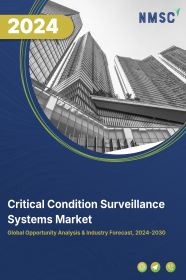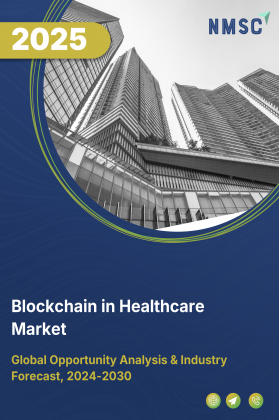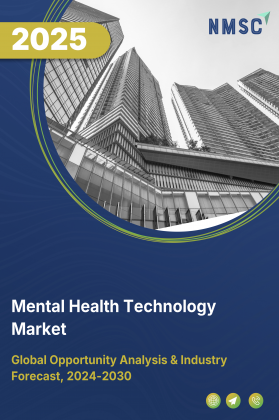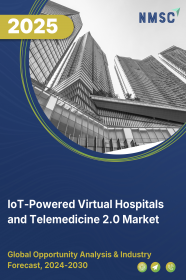
Critical Condition Surveillance Systems Market by Product (Remote Patient Monitoring Systems, Telehealth Systems, and Wearable Medical devices), by Component (Hardware, Software, and Services), by Technology (Wireless and Wired Technology), by Indication (Cardiology, Neurology, Pulmonology, and Others), and by Application (Hospitals, Home Healthcare, and Ambulatory Care Centres) - Global Opportunity Analysis and Industry Forecast 2024-2030
Market Definition
The Critical Condition Surveillance Systems Market size was valued at USD 33.88 billion in 2023 and is predicted to reach USD 66.58 billion by 2030 with a CAGR of 10.1% from 2024-2030.
A critical condition surveillance system is a type of monitoring system that is used in healthcare facilities to monitor and alert medical personnel to the vital signs of patients who are critically ill. These systems are designed to monitor changes in a patient's condition, detect early signs of illness, and provide rapid responses to life-threatening conditions. This allows medical staff to intervene quickly and provide faster diagnosis and treatment. Critical condition surveillance system typically consists of sensors, monitoring devices, and software that track a patient's vital signs, such as blood pressure, heart rate, oxygen saturation, and temperature. The system then sends alerts to medical staff when a patient's condition changes or when the patient's vitals reach a critical threshold.
Market Dynamics and Trends
The demand for critical condition surveillance systems is significantly boosted due to the rapidly growing geriatric population across the globe. According to the latest report published by the World Bank, about 10 % of the global population is above the age of 65 in 2022, and it is expected to rise significantly in the coming years. As old-age people are more prone to chronic disease, the need for critical condition surveillance systems is poised to rise, driving the growth of the market.
Moreover, the increasing prevalence of chronic diseases such as diabetes, heart disease, and cancer are driving the widespread use of critical condition surveillance systems in hospitals and clinics, further driving the growth of the critical condition surveillance systems market.
As per the latest report published by the World Health Organization, more than 41 million people die from chronic disease every year, equivalent to 74% of all global deaths. Cardiovascular diseases account for most deaths followed by cancers, chronic respiratory diseases and diabetes.
However, the high cost of implementing a critical condition surveillance system along with the privacy concerns associated with its use are the major factors restraining the growth of the critical condition surveillance systems market. On the contrary, the introduction of artificial intelligence and machine learning in critical condition surveillance systems is expected to create ample opportunity in the coming years.
This advancement is anticipated to enhance patient monitoring and facilitate early detection of diseases by leveraging machine learning algorithms, using data stored in electronic medical records. This analytical approach enables the prediction of intensive care unit (ICU) mortality and the length of stay for patients, showcasing the potential for improved healthcare outcomes and resource management.
Market Segmentations and Scope of the Study
The critical condition surveillance systems market share is segmented on the basis of product, component, technology, indication application, region. On the basis of product, the market is divided into remote patient monitoring systems, telehealth systems, and wearable medical devices. On the basis of component, the market is classified into hardware, software, and services. On the basis of technology, the market is segmented into wired and wireless technology. On the basis of indication, the market is divided into cardiology, neurology, pulmonology, and others. On the basis of application, the market is classified into hospitals, home healthcare, and ambulatory care centers. Regional breakdown and analysis of each of the aforesaid segments include regions comprising of North America, Europe, Asia-Pacific, and RoW.
Geographical Analysis
North America holds the dominant share of the critical condition surveillance systems market and is expected to continue its dominance during the forecast period. This is attributed to factors such the growing number of chronic diseases including cardiovascular, respiratory, and cancer in this region.
According to the Centers for Disease Control and Prevention, heart disease is the leading cause of death for men and women in the U.S. This growing burden of chronic illnesses is driving the demand for advanced surveillance systems for timely and effective healthcare interventions in this region.
Furthermore, the presence of key players such as Medtronic plc and GE Healthcare plays an important role in the growth of the critical condition surveillance market in this region. For instance, in May 2021, Medtronic plc launched a new pediatric monitor the ‘Sonarmed Airway Monitoring System’, that alerts clinicians to potential airway obstructions during ventilation. The new system utilizes acoustic technology to check for endotracheal tube obstruction and verify position in real-time, giving doctors vital information to make more informed and life-saving decisions.
On the other hand, Asia Pacific is expected to show a steady rise in the growth of the critical condition surveillance systems market. This is due to the growing geriatric population in countries such as Japan, China, and Indonesia who are more susceptible to various diseases and require continuous medical monitoring.
According to the World Bank statistics, the population above the age of 65 years was 30% in Japan in 2022. The rising prevalence of age-related health concerns in the Asia Pacific region drives the demand for advanced critical condition surveillance systems to cater to the healthcare needs of this demographic.
Moreover, the increasing investment in healthcare infrastructure by the government to provide high-quality medical facilities is further boosting the growth of the critical condition surveillance system market in this region. For instance, in September 2022, the State Council of China's highest state authority, introduced a loan incentive policy for the medical sector. The government allowed USD 29 billion specifically allocated for the upgrading of medical facilities and the advancement of medical technology, including the adoption of critical condition surveillance systems.
Competitive Landscape
Various market players operating in the critical condition surveillance systems market include Philips Healthcare, Medtronic plc, GE Healthcare, Masimo Corporation, Siemens Healthineers, Drager Medical, Nihon Kohden Corporation, Omron Healthcare, EarlySense Ltd., Hill-Rom Holdings, Health Monitoring Systems, Cisco Systems Inc., CareFusion Corporation, Mindray Medical International Limited, and Apollo Hospitals Enterprise Limited, and others. These market players are adopting various strategies such as product launches and medical clearances to remain dominant in the critical condition surveillance systems market.
For instance, in December 2022, Mindray introduced a new wearable patient monitoring system named mWear to track patient conditions. The new device supports comprehensive and precise measurements of patient status and also enables hospitals to extend home hospital practice with a universal CMS platform.
Moreover, in October 2022, Apollo Hospitals launched a rapid response patient monitoring system. The new system is designed to monitor and proactively alert a team of experts if it anticipates an unexpected deterioration in patient health.
Furthermore, in March 2022, Philips Healthcare launched the Philps Capsule Surveillance system that received FDA clearance. The new Surveillance system utilises data from connected medical devices, generate actionable insights and alerts, and sends timely notifications for intervention before deterioration progresses further.
Key Benefits
-
The report provides quantitative analysis and estimations of critical condition surveillance systems market from 2024 to 2030, which assists in identifying the prevailing market opportunities.
-
The study comprises a deep dive analysis of the critical condition surveillance systems market including the current and future trends to depict prevalent investment pockets in the market.
-
Information related to key drivers, restraints, and opportunities and their impact on the critical condition surveillance systems market is provided in the report.
-
Competitive analysis of the players, along with their market share is provided in the report.
-
SWOT analysis and Porters Five Forces model is elaborated in the study.
-
Value chain analysis in the market study provides a clear picture of roles of stakeholders.
Key Market Segments
By Product
-
Remote Patient Monitoring Systems
-
Telehealth Systems
-
Wearable Medical devices
By Component
-
Hardware
-
Software
-
Services
By Technology
-
Wireless
-
Wired Technology
-
By Indication
-
Cardiology
-
Neurology
-
Pulmonology
-
Others
By Application
-
Hospitals
-
Home Healthcare
-
Ambulatory Care Centers
By Region
-
North America
-
The U.S.
-
Canada
-
Mexico
-
-
Europe
-
The UK
-
Germany
-
France
-
Italy
-
Spain
-
Denmark
-
Netherlands
-
Finland
-
Sweden
-
Norway
-
Russia
-
Rest of Europe
-
-
Asia Pacific
-
China
-
Japan
-
India
-
South Korea
-
Australia
-
Indonesia
-
Singapore
-
Taiwan
-
Thailand
-
Rest of Asia Pacific
-
-
RoW
-
Latin America
-
Middle East
-
Africa
-
KEY PLAYERS
-
Philips Healthcare
-
Medtronic plc
-
GE Healthcare
-
Masimo Corporation
-
Siemens Healthineers
-
Drager Medical
-
Nihon Kohden Corporation
-
Omron Healthcare
-
EarlySense Ltd.
-
Hill-Rom Holdings
-
Health Monitoring Systems
-
Cisco Systems Inc.
-
CareFusion Corporation
-
Mindray Medical International Limited
-
Apollo Hospitals Enterprise Limited
REPORT SCOPE AND SEGMENTATION:
|
Parameters |
Details |
|
Market Size in 2023 |
USD 33.88 Billion |
|
Revenue Forecast in 2030 |
USD 66.58 Billion |
|
Growth Rate |
CAGR of 10.1% from 2024 to 2030 |
|
Analysis Period |
2023–2030 |
|
Base Year Considered |
2023 |
|
Forecast Period |
2024–2030 |
|
Market Size Estimation |
Billion (USD) |
|
Growth Factors |
|
|
Countries Covered |
28 |
|
Companies Profiled |
15 |
|
Market Share |
Available for 10 companies |
|
Customization Scope |
Free customization (equivalent up to 80 working hours of analysts) after purchase. Addition or alteration to country, regional, and segment scope. |
|
Pricing and Purchase Options |
Avail customized purchase options to meet your exact research needs. |




















 Speak to Our Analyst
Speak to Our Analyst

























